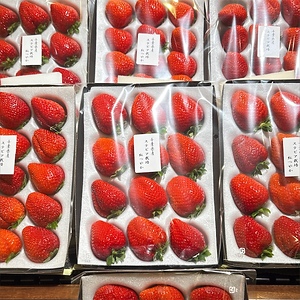


Beni Tsuyaka Strawberries
Estimated Inventory, lb : 0
Description/Taste
Beni Tsuyaka strawberries are a stevia-sweetened fruit from Japan. They have a rounded conical shape, with some strawberries featuring a pointier end or wider top than others. Beni Tsuyaka strawberries typically weigh around 30 grams each and have shiny, glossy, and bright red skin. Their yellow seeds are relatively large and embedded all over the surface of the fruit. Their flesh has a pale pink-red hue that extends all the way to the core of the strawberry. This flesh is hard and firm yet easy to bite into. The center of the strawberry is hollow, approximately the size of a single almond. Each aromatic fruit is enhanced with a concentrated stevia extract, making them much sweeter than other types of strawberries. This added sweetness balances their natural acidity and sourness, resulting in a refreshing and well-rounded flavor.
Seasons/Availability
In Japan, Beni Tsuyaka strawberries are available from December to May, with a peak season from January to March.
Current Facts
The botanical name for Beni Tsuyaka strawberries is Fragaria ananassa and they belong to the Rosaceae family, which also includes apples, raspberries, cherries, pears, and roses. Beni Tsuyaka is not a variety but a brand name for Sachinoka strawberries that have been cultivated using concentrated stevia extract. Stevia is a plant native to Paraguay that contains a natural sweetener that's often used in its powder or liquid form as an alternative to sugar in beverages and baked goods. The process of gathering this natural sweetener starts with extracting the leaves and stems of the stevia plant, fermenting these extractions for about two years, and then using them to cultivate these strawberries. In addition to enhancing the fruit's sweetness, stevia is believed to reduce harmful substances from pesticides and chemical fertilizers in the soil and to extend the vibrant red color of these strawberries. Japan has become known for developing unique strawberry varieties with soft, delicate, and juicy textures that are less sour than breeds from the United States. These fruits are traditionally packed in colorful, decorative gift boxes to optimize transportability and longevity.
Nutritional Value
Beni Tsuyaka strawberries are said to contain more vitamin C than other types of strawberries, contributing to immune and cardiovascular health, collagen production, iron absorption, wound healing, cognitive function, and decreased free radical cell damage. Strawberries in general are a good source of folate, a B vitamin that benefits reproductive health, serotonin production, cellular function, and red blood cell formation. This fruit also provides the body with potassium, helping support fluid balance, blood sugar and blood pressure regulation, digestion, and nerve, kidney, and muscle function.
Applications
Beni Tsuyaka strawberries are commonly eaten fresh because of their succulent, sweet nature but can also be baked or preserved. They are frequently eaten fresh out of hand or used as a topping for desserts like strawberry shortcakes, trifles, oatmeal, granola, cheesecake, ice cream, waffles, and pancakes. This fruit pairs well with beverages like iced tea, smoothies, lemonade, daiquiris, margaritas, and mojitos. Beni Tsuyaka strawberries bode well for syrups, dessert sauces, salad dressings, jams, compotes, and cake fillings. They can be used to add a touch of sweetness to savory dishes like spinach salads, quinoa bowls, flatbreads, glazed salmon, strawberry skewers, and charcuterie boards. These strawberries pair well with rhubarb, bananas, apples, mangoes, kiwi, avocados, grilled chicken and shrimp, peanut butter, feta cheese, basil, sage, jalapeños, lemons, limes, dates, Greek yogurt, whipped cream, chocolate, and marshmallows. Beni Tsuyaka strawberries should be stored in their original packaging, which typically includes a container that prevents each fruit from overlapping and a protective sheet to cover them. Keep the strawberries dry until ready to eat and store them in the refrigerator for up to a week.
Ethnic/Cultural Info
Strawberries have become an important part of Christmas Day festivities in Japan. A post-World War II tradition is creating Christmas sponge cakes topped with whipped cream and fresh strawberries like the Beni Tsuyaka variety. Before making this cake, it is customary to go strawberry picking with baskets, as December is their peak season in Japan. Another food that’s often enjoyed for Christmas dinner is Kentucky Fried Chicken, a restaurant that was established in Japan during the 1970s. These eclectic traditions are a reflection of how Japan blends Western practices with their own culture and cuisine.
Geography/History
Beni Tsuyaka strawberries were first developed in the Chiba Prefecture of the Kanto region of Japan, where most of the production still occurs. They were initially sold under the name Stevia Sachinoka but were changed to Beni Tsuyaka strawberries in 2011. Strawberries were first grown in Japan during the 1960s and technological advancements over the following decades led to the advent of the first Japanese variety in the 1990s, the Tochiotome strawberry. Since then, many types have been developed, including Beni Tsuyaka strawberries. These grow best in temperate climates with cool winters, moderate humidity, and high sun exposure but can also be sown in greenhouses. As a premium cultivated strawberry enhanced with stevia extract, Beni Tsuyaka strawberries are mostly produced by growers rather than home gardeners. They are primarily found in Japan, particularly in the Chiba Prefecture, in high-end specialty stores. If Beni Tsuyaka strawberries are available outside of Japan, they are most likely to be found in Asian markets.








